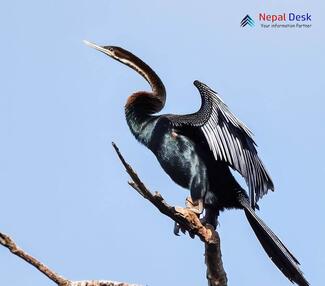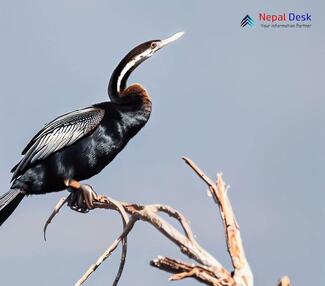Among the diverse species that inhabit the captivating land of Nepal, the Oriental Darter (Anhinga melanogaster) is one of them. This unique bird, often referred to as the "snakebird" due to its serpentine neck, can be found inhabiting Nepal's wetlands and water bodies. It is a member of the darter family, Anhingidae, and is closely related to American (Anhinga anhinga), African (Anhinga rufa, with vulsini of Madagascar as a subspecies), and Australasian (Anhinga novaehollandiae) darters. These were for some time treated as subspecies of Anhinga melanogaster. The Oriental darter differs in appearance from American darters most recognisably by its white lateral neck stripe.
In this article, we will delve into the mysterious world of the darter, exploring its fascinating behavior, preferred habitats, and conservation efforts aimed at protecting this enigmatic creature.
Revelations on Oriental Darter Behavior
The oriental darter is an adept swimmer and diver, using its slender body and avian nature to glide effortlessly through the water in search of prey. The diet of Anhinga melanogaster predominantly consists of small fish, amphibians, and aquatic insects. The darter's hunting strategy entails stalking its prey beneath the water surface before latching onto it with lightning-fast speed using its sharp beak.
Once it has reeled in its catch, the darter then painstakingly maneuvers the captured prey out of the water and into the air for consumption. After a successful hunt, these birds are often seen perched with wings spread out on branches or rocks near their hunting grounds to dry off their waterlogged feathers.
The Enchanting Habitats of The Oriental Darters in Nepal
In Nepal, oriental darters are commonly found in areas rich in freshwaters such as wetlands, swamps, and riversides. Notably dispersed throughout protected regions like Chitwan National Park and Bardiya National Park – these locations offer ideal settings for breeding and feeding thanks to their abundance of food sources and safe nesting sites.
Conservation Hopes: Protecting the Anhinga melanogaster
Although currently listed as a species of "Least Concern" by the International Union for Conservation of Nature (IUCN), darters still face certain threats, such as loss of habitat, pollution, and human disturbance. Therefore, ongoing conservation efforts are vital to safeguard the well-being of this captivating species. Preservation of wetlands and effective waste management are critical factors in ensuring a healthy environment for Anhinga melanogaster to continue flourishing.
If you ever find yourself traversing the majestic landscapes of Nepal, be sure to keep an eye out for this enthralling avian resident. The sight of an oriental darter in its natural habitat, displaying its unique form and remarkable hunting skills, is truly an experience that one will not soon forget.




